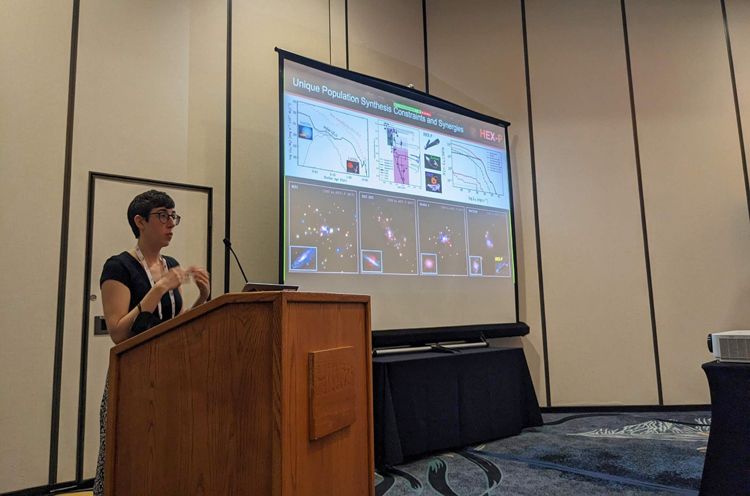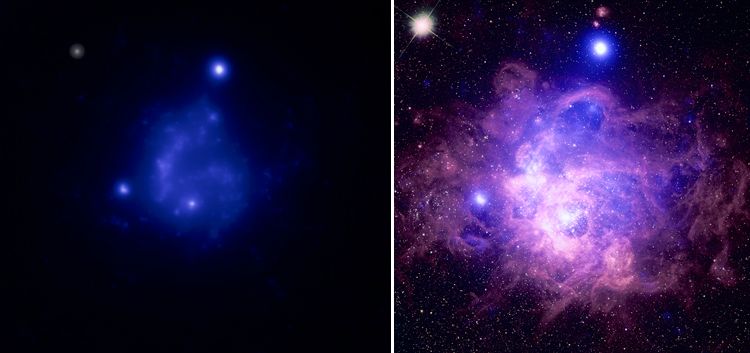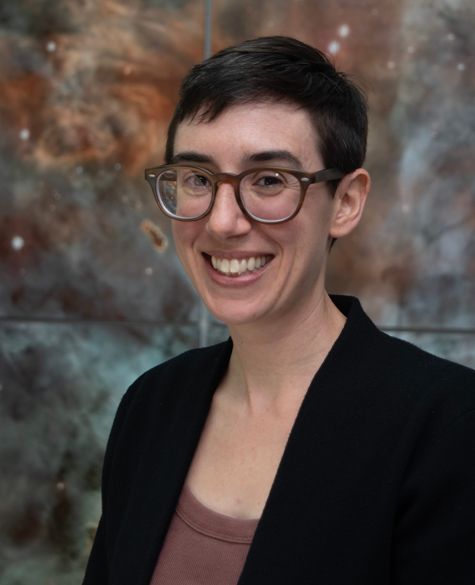Early Career Scientist Spotlight
Dr. Kristen Garofali (she/her/hers)
High-Energy Astrophysicist
X-ray Astrophysics Laboratory (662)
What is your research focus?
I study X-ray binaries—systems where a black hole or neutron star accretes material from a less evolved stellar companion—to understand their role in shaping cosmic history. Early in the history of the Universe, in an era known as the cosmic Dark Ages, neutral hydrogen pervaded the cosmos making the Universe opaque. As the first stars in the first galaxies turned on, they emitted photons capable of ionizing this neutral hydrogen. Eventually, the Universe became reionized, but exactly how this reionization occurred is still an open question. Evidence from cosmological experiments suggests that the high-energy photons from the first X-ray binaries—which formed in tandem with the first stars—may have played a critical role in heating the neutral hydrogen in the intergalactic medium before reionization, ultimately altering how reionziation proceeded.
The impact of X-ray heating from X-ray binaries in the early Universe depends critically on the properties of the X-ray binary populations in the earliest galaxies. Unfortunately, we cannot directly observe these populations, due to redshift effects. To help address this, I study populations of X-ray binaries in relatively nearby galaxies to understand how the populations change as a function of the host galaxy properties, such as history of star formation and chemical abundance pattern. The advantage of studying extragalactic X-ray binary populations is that large numbers of sources can be observed with few telescope pointings, yielding statistically significant samples with which to study correlations between the number and brightness of sources and the host galaxy properties. To detect and characterize these extragalactic X-ray binary populations, I use data from telescopes such as Chandra, XMM-Newton, NuSTAR, and Hubble. The correlations I investigate for X-ray binaries in nearby galaxies provide conditions analogous to those in the earliest galaxies when the Universe was very young, thereby helping to shed light on the role of X-ray binaries in reionization.

Credit: HEX-P Communications Team
What inspired you to pursue a career in astrophysics?
My parents were a big inspiration to me for pursuing a career in science. My mom, a former math teacher, took extra time to teach me arithmetic at our kitchen table, and my dad, a science teacher for 35 years, instilled in me a love and curiosity for all things science (and science fiction). In high school, I got the chance to experience studying astrophysics when I participated in a summer program at a nearby university. For the program, I built a cosmic ray experiment and attended lectures from nuclear astrophysicists. After participating in this program, I was sure I wanted to pursue studying astrophysics in college. My parents were extremely supportive of my education and my interest in astrophysics, and this gave me an incredible boost to pursue this career.
What aspects of your work are you most passionate about?
I love that my work allows me to practice lots of different skillsets. I get to engage in technical writing, science communication, education and mentorship, coding, and data visualization, just to name a few. I also love that I get to collaborate with tons of brilliant and interesting people, from whom I’m always learning new things.
If you were to expand your current research focus, what new topics would you explore?
I’m interested in moving up the mass scale for black holes and getting involved in the search for intermediate mass black holes. Black holes in the intermediate mass regime and somewhat elusive, falling between stellar mass black holes (like those in X-ray binaries) and supermassive black holes (like those at the centers of galaxies). I am currently working on simulations of the observational signatures of accreting intermediate mass black holes to determine how they can be distinguished from very luminous X-ray binaries. I’m looking forward to using the results from these simulations to plan future observations to hunt for black holes.
What early career advice do you have for those looking to do what you do?
Find people in the field that support you, and that you enjoy working with. Having a strong peer cohort and excellent mentorship are invaluable at any career stage, but especially when you are just starting out.

Credit: Kristen Garofali
What do you like to do in your free time?
To relax, I like to cook and/or watch movies. I love making pasta by hand (very meditative), and I am a huge fan of watching horror movies (less mediative, but fun nonetheless). Since moving to DC, I enjoy getting out to explore all the (free) things that the District has to offer. One of my favorite places is the National Arboretum, which is an incredible place to wander during any season.

Credit: Kristen Garofali
What is one of your favorite moments in your career so far?
As a post-doctoral researcher, I discovered the most distant colliding-wind binary known to date in the giant star-forming region NGC 604 in M33. The source shares some characteristics with the famous Galactic colliding-wind binary, Eta Carinae. The discovery was highlighted in a new image of NGC 604 created to commemorate the 20th anniversary of the Chandra X-ray Observatory. It was really exciting to be part of a new discovery, 20 years into Chandra’s lifetime!

Credit: X-ray: NASA/CXC/Univ. of Arkansas/K. Garofali et al.; Optical: NASA/AURA/STScI/J. Schmidt)
Biography
Home Town:
Detroit, MI
Undergraduate Degree:
BS Physics, Astrophysics; Michigan State University; East Lansing, MI
Post-graduate Degrees:
PhD Astronomy; University of Washington; Seattle, WA

Link to Dr. Garofali's GSFC Bio
